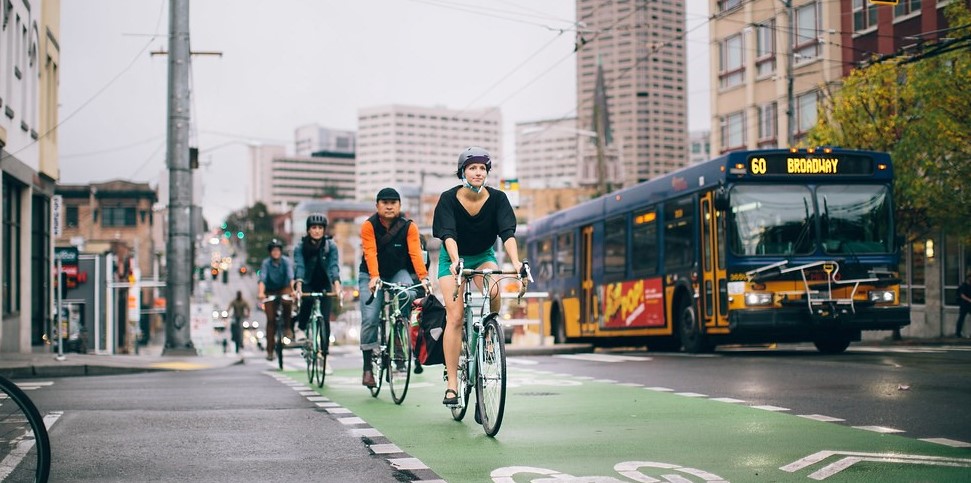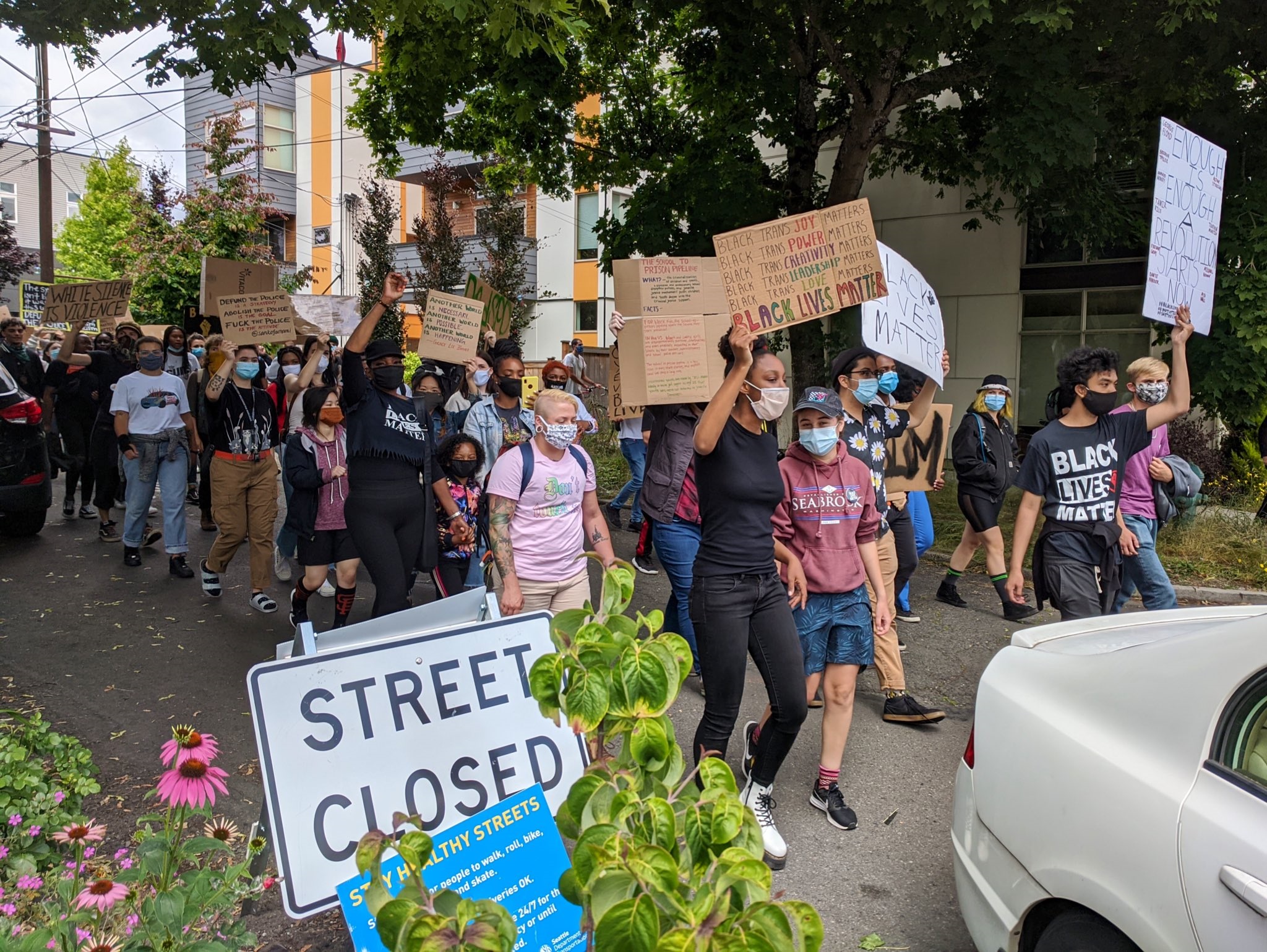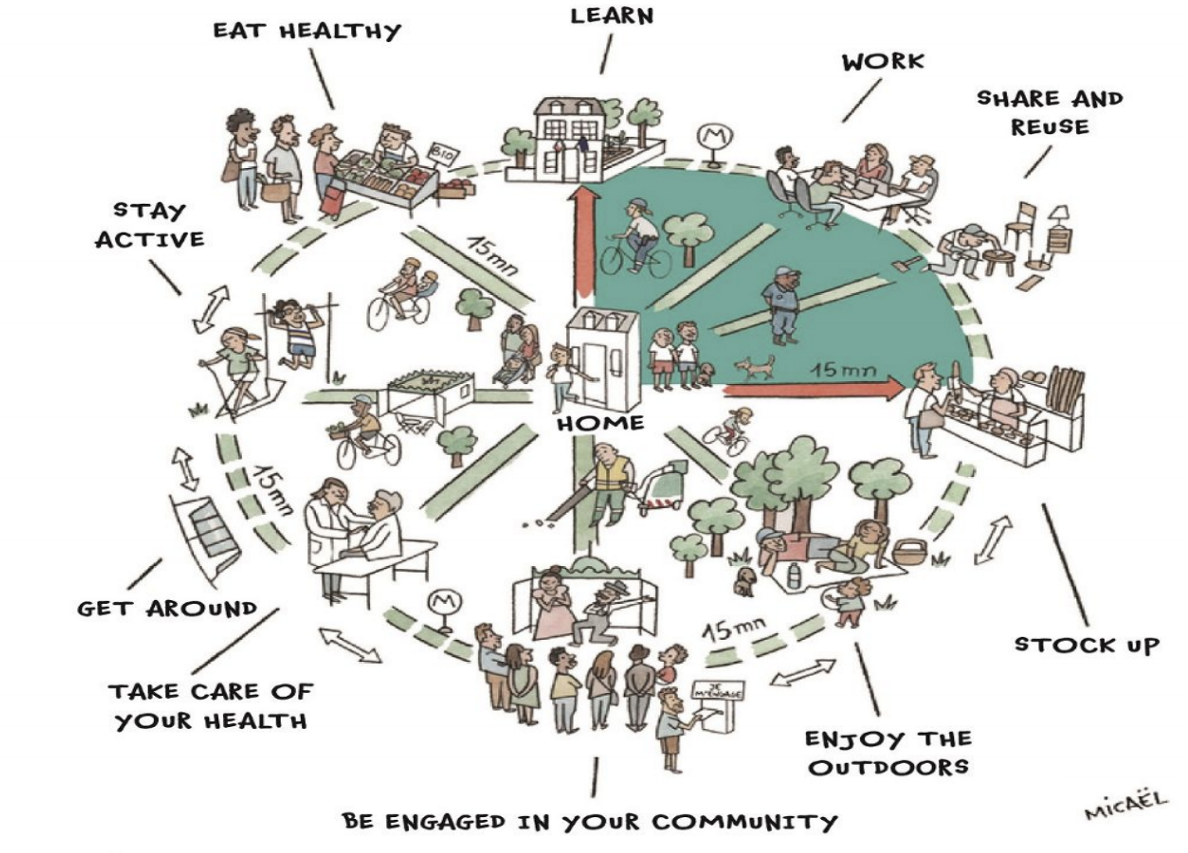Poll: Seattle voters support streets for people
- seattlegreenways
- Nov. 17, 2021
 In brief, we found Seattle voters...
In brief, we found Seattle voters...
- Share common values for how to shape the future of our streets
- Support giving space for safe routes to school, bike lanes, sidewalks, street cafes, and bus lanes even when it means removing a lane of traffic or parking
- Are eager to implement transformational ideas
Shared values
 When planning for our transportation future, the vast majority of Seattle voters thought that our elected leaders should take into account safety, racial equity, sustainability, accessibility, affordability, convenience, kid-friendly, health, and happiness.
These values are what underpin Seattle Neighborhood Greenway's vision and work, so seeming them shared so strongly was heartening and will help guide how we talk about what we do.
When planning for our transportation future, the vast majority of Seattle voters thought that our elected leaders should take into account safety, racial equity, sustainability, accessibility, affordability, convenience, kid-friendly, health, and happiness.
These values are what underpin Seattle Neighborhood Greenway's vision and work, so seeming them shared so strongly was heartening and will help guide how we talk about what we do.
Support for bike lanes, sidewalks, cafe streets, and bus lanes — even when it means removing parking or travel lanes
 Even when it comes to seemingly contentious transportation projects that require converting a lane or traffic or parking spaces, Seattle voters were overwhelmingly supportive. They are willing to convert travel lanes and parking lanes into more space for kids to get to school, outdoor dining, wider sidewalks, safe bike lanes, and bus lanes. This scientific polling finds that Seattle voters are in fact more united around an inclusive transportation vision, even when there are difficult tradeoffs, than parts of the public discourse would lead us to believe.
We hope this finding encourages Mayor Elect Harrell and SDOT to be bold in proposing street improvements that reflect our shared values as a city, even when it feels challenging, since they will know the public has their back.
Even when it comes to seemingly contentious transportation projects that require converting a lane or traffic or parking spaces, Seattle voters were overwhelmingly supportive. They are willing to convert travel lanes and parking lanes into more space for kids to get to school, outdoor dining, wider sidewalks, safe bike lanes, and bus lanes. This scientific polling finds that Seattle voters are in fact more united around an inclusive transportation vision, even when there are difficult tradeoffs, than parts of the public discourse would lead us to believe.
We hope this finding encourages Mayor Elect Harrell and SDOT to be bold in proposing street improvements that reflect our shared values as a city, even when it feels challenging, since they will know the public has their back.
Transformational ideas are popular
 Overall, the public is very supportive of transformational ideas like creating pedestrian only streets, shifting the enforcement of traffic laws from SPD to SDOT, implementing a 15 Minute City vision, and creating more Home Zones and Stay Healthy Streets.
Overall, the public is very supportive of transformational ideas like creating pedestrian only streets, shifting the enforcement of traffic laws from SPD to SDOT, implementing a 15 Minute City vision, and creating more Home Zones and Stay Healthy Streets.
 Strong support for pedestrian only streets
The public is overwhelmingly supportive (81%) of seeing more pedestrian only shopping streets. These streets could build off the success of the city's Cafe Streets program, which has allowed small businesses to thrive by using street space for retail, dining, and other uses. The city should create permanent policies to allow for pedestrianized small business streets, so that we can help our local economy thrive during this difficult time, and rebound after the pandemic, guided by new research of how to create successful pedestrian only streets.
Strong support for pedestrian only streets
The public is overwhelmingly supportive (81%) of seeing more pedestrian only shopping streets. These streets could build off the success of the city's Cafe Streets program, which has allowed small businesses to thrive by using street space for retail, dining, and other uses. The city should create permanent policies to allow for pedestrianized small business streets, so that we can help our local economy thrive during this difficult time, and rebound after the pandemic, guided by new research of how to create successful pedestrian only streets.
 Traffic enforcement is an area of consensus for the policing debate
The public is very supportive (73%) of transferring traffic enforcement duties away from SPD and to the Seattle Department of Transportation. This would result in more equitable outcomes, because traffic stops are the #1 way the public interact with the police, which as we know can escalate with tragic deadly consequences, especially for people of color. It would also result in a more pragmatic approach, that would refocus traffic enforcement towards problem solving to keep people safe, rather than just writing tickets. Leaders at the state level should propose legislation to allow this common sense solution, so that cities can move traffic enforcement responsibilities from police departments to transportation departments. This would be a more equitable, efficient, and safe system for everyone.
Traffic enforcement is an area of consensus for the policing debate
The public is very supportive (73%) of transferring traffic enforcement duties away from SPD and to the Seattle Department of Transportation. This would result in more equitable outcomes, because traffic stops are the #1 way the public interact with the police, which as we know can escalate with tragic deadly consequences, especially for people of color. It would also result in a more pragmatic approach, that would refocus traffic enforcement towards problem solving to keep people safe, rather than just writing tickets. Leaders at the state level should propose legislation to allow this common sense solution, so that cities can move traffic enforcement responsibilities from police departments to transportation departments. This would be a more equitable, efficient, and safe system for everyone.
 Talking about 15 Minute Cities brings people together
Conversations around zoning and land use can be contentious, but the public is overwhelmingly supportive (81%) of adding more housing, retail, and neighborhood amenities to make it so that people can walk to their daily needs in fifteen minutes or less. Our ask: This 15 Minute City concept could bring people together around a shared vision for how we should grow as a city, and should be used as a foundation for updating the city's zoning and land use plan (called the Comprehensive Master Plan).
Talking about 15 Minute Cities brings people together
Conversations around zoning and land use can be contentious, but the public is overwhelmingly supportive (81%) of adding more housing, retail, and neighborhood amenities to make it so that people can walk to their daily needs in fifteen minutes or less. Our ask: This 15 Minute City concept could bring people together around a shared vision for how we should grow as a city, and should be used as a foundation for updating the city's zoning and land use plan (called the Comprehensive Master Plan).
 Stay Healthy Streets and Home Zones remain popular
The poll found that 67% of people support efforts like Stay Healthy Streets and Home Zones that limit traffic on neighborhood streets to local access only. These two pilot programs have been a lifeline during the pandemic, and they have also been a successful experiment showing the way towards a better future. The Seattle City Council is working to add funding to the Home Zone program for next year, which is a cost-effective way to make neighborhoods, especially those without sidewalks, a safer and more comfortable place to walk. Outgoing Mayor Durkan promised at least 20 miles of permanent Stay Healthy Street, a promise which Mayor-elect Harrell has said he will expand upon. We laid out a vision for how the Stay Healthy Street program can better serve all Seattlites.
Stay Healthy Streets and Home Zones remain popular
The poll found that 67% of people support efforts like Stay Healthy Streets and Home Zones that limit traffic on neighborhood streets to local access only. These two pilot programs have been a lifeline during the pandemic, and they have also been a successful experiment showing the way towards a better future. The Seattle City Council is working to add funding to the Home Zone program for next year, which is a cost-effective way to make neighborhoods, especially those without sidewalks, a safer and more comfortable place to walk. Outgoing Mayor Durkan promised at least 20 miles of permanent Stay Healthy Street, a promise which Mayor-elect Harrell has said he will expand upon. We laid out a vision for how the Stay Healthy Street program can better serve all Seattlites.
 School Streets need to demonstrate their benefit better
While safe routes to school projects in general are wildly popular (84% in the tradeoff question), the School Streets pilot that allows schools to close their adjacent streets to create a safer and more orderly way for kids to walk, bike, and bus only got 55% support. Participating schools report that this has calmed what can be a hectic and dangerous time around the start and end to the school day, but these stories have not yet been widely reported. We think that with more public education of the benefits of this SDOT pilot program, the public would be even more supportive.
School Streets need to demonstrate their benefit better
While safe routes to school projects in general are wildly popular (84% in the tradeoff question), the School Streets pilot that allows schools to close their adjacent streets to create a safer and more orderly way for kids to walk, bike, and bus only got 55% support. Participating schools report that this has calmed what can be a hectic and dangerous time around the start and end to the school day, but these stories have not yet been widely reported. We think that with more public education of the benefits of this SDOT pilot program, the public would be even more supportive.
 Sidewalk repair
Sidewalk repair
Did you know that repairing sidewalks are the responsibility of the adjacent property owner? Many people do not, and there is little help or incentive for them to do so. There are 150,000 known sidewalk hazards, which can be dangerous and completely block access for folks walking and rolling.
-
The City of Seattle recently conducted an audit on current sidewalk repair policies and programs and recommended the Oakland buy/sell/repair ordinance which requires property owners to bring sidewalks into compliance before a property is sold. Oakland reported a 65% increase in sidewalk repairs after this was implemented. To do this equitably the city would need to set up a revolving fund to give property owners access to funds before the sale goes through to make the repair, and to subsidize low income land owners. This would essentially function like a capital gains tax on property sales, that would capture some of the skyrocketing wealth created by owning land.
-
A better long term solutions would be for the State Legislature to give Seattle more options for progressive taxation to fully fund the city run sidewalk repair program, but in the meantime Seattle should do what it can to make our sidewalks more accessible. We understand why on its face this idea is less popular (45% support, 8% unsure) than the others we polled about, but we think that when all of this is explained it will be seen as a progressive and pragmatic temporary solution, while we wait on Olympia to deliver better revenue options to fully fund a City of Seattle run program.
-
In summary, Seattle voters...
- Share common values for how to shape the future of our streets
- Support giving space for safe routes to school, bike lanes, sidewalks, street cafes, and bus lanes even when it means removing a lane of traffic or parking
- Are eager to implement transformational ideas
 These ideas are widely popular, and passionately supported
These ideas are widely popular, and passionately supported